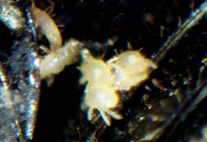Abstract
Due to the higher resolution, confocal microscopy (CLSM) can be applied to refine the origin of tiny structures of the autofluorescent exoskeletons of microarthropods (mites in particular) which are hard to visualize using traditional differential interference contract light microscopy (DIC LM) and phase contrast light microscopy (PC LM). Three-dimensional (3D) reconstructions of the prodorsal shield topography of eriophyoid mites using Neoprothrix hibiscus Reis and Navia as a model, suggest that the structures originally treated as paired setae vi are two internal rod-like apodemes. Based on this, the genus Neoprothrix is excluded from the subfamily Prothricinae Amrine and transferred to the subfamily Sierraphytoptinae Keifer. Observations on partially cleared specimens of N. hibiscus showed that remnants of the central nervous system, paired glands and developing oocytes can be visualized using DIC LM and CLSM methods. New high quality microscope images are provided of recently described “flower-shaped” structures and two main components of yolk inclusions of the mature eggs inside the oviduct.

